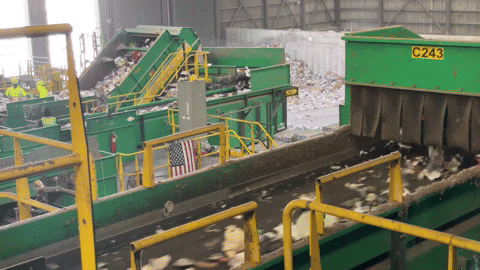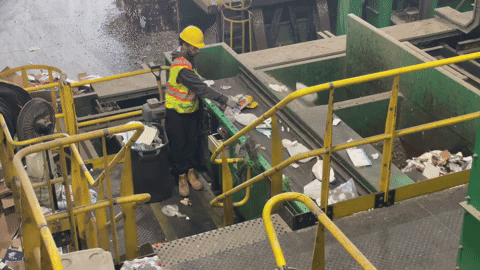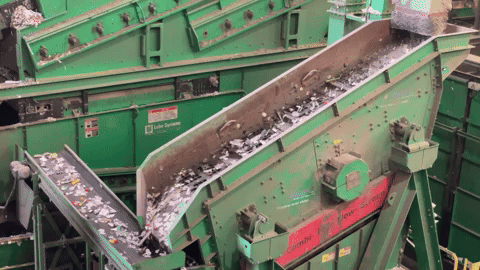Behind the Scenes at a MRF: Unveiling the Journey of Your Recyclables
- David New
- Nov 6, 2024
- 5 min read
I recently had the opportunity to tour the local material recovery facility (MRF) that sorts the recyclables for my town, and I wanted to share the experience. If you ever get the opportunity to tour a MRF, I highly recommend it. You will get a much better appreciation and deeper understanding of what happens to the contents of your household recycling bin. Many thanks to Gretchen Carey, Sustainability Manager, Republic Services, for conducting the tour and for allowing me to participate.
The particular facility I toured is operated by Republic Services, the second largest waste management company in the US . This plant, in Peabody, MA, was purchased from JRM about 2 years ago.
Perhaps the first thing you notice when you visit the plant is the dust; sorting recyclables is a dusty, dirty process. And maybe the second thing you notice is the massive array of machinery and conveyor belts, in constant motion, processing the recyclables from dozens of towns. We were able to observe the process from the safety of a viewing area.
At its most basic, all a MRF does is take the mixed recyclables from your household, and puts them onto the machinery, where they get sorted by commodity type into separate bins, and eventually compressed into huge 2,000-pound cubes (called bales). When the MRF has enough bales, they are sold to re-processors, loaded onto trucks and shipped off to their customer's plants that do the actual work of recycling the commodities into paper, cardboard, aluminum, steel, and various plastic products.
One of the other things you notice (in the lower left of the video above), is the big pile of stuff, mostly plastic bags and other unwanted materials. This big pile is sometimes referred to as "residue," material that was in the recycling bins, but could not be sorted by the equipment and will eventually go to landfill. At this facility, about 85% of the incoming material is sorted into the commodity bales, and only about 15% ends up in landfill. This is very good; at a typical MRF, up to 30% or more of incoming material goes to landfill.
There are over 300 MRFs in the United States, and while they are all a little different, they also share a lot of similarities in how they process material.
Typically, the first thing that happens is, the contents of the truck are dumped directly onto the floor. Sometimes, the pile is picked through, using power equipment, to remove large items like big clumps of cardboard. Next, a front-end loader scoops the remaining stuff off the ground and dumps it into a hopper at the beginning of the process.
Often, the next thing that happens is, the material flows over a piece of equipment called a 2D/3D separator (the slanted machine in the upper left corner of the image above) which, as the name implies, separates the flat material (paper and cardboard) from 3-dimensional material like cans, bottles, and plastic containers. The flat 2D material flows over the top, and the 3D material falls through onto a conveyor belt below.
From the conveyor belt, glass containers are often the first commodity to be sorted out. The glass is crushed, and accumulates in a big pile. Ferrous metals (like soup cans) are then removed as they pass by a huge magnet, and aluminum is removed as it passes through an eddy-current separator.
The material left on the conveyor belt is mostly various types of plastics and contaminants, and here is where there tends to be a lot of variation in how MRFs are configured. The goal is always to separate out just the material where there is a customer waiting who wants to buy the material, and to do it in as efficient a manner as possible. Sometimes, the easiest way to separate the material is to manually pick it off the line, as shown above. Notice that the worker is pulling plastic bags and putting them in a garbage can (headed for landfill), and throwing flattened, opaque, milk jugs into a special hopper.
But while humans are often used to remove contaminants and "tanglers" (things that tend to wrap around and jam up equipment), most of the other sorting and separation processes are automated. Optical scanners can detect the clear water bottles and clear take-out clamshells, and other types of recyclable containers like laundry soap bottles.
A few new things I learned from the tour:
Leave the tops on containers. When the tops are attached, the material can be recycled. When the tops are loose, they are too small to handle and end up in landfill.
In Massachusetts, you can recycle #1 - PET clear "clam shell" containers, such as from the supermarket bakery
You can recycle #5 - PP (polypropylene) such as yogurt, sour cream, and cottage cheese tubs
Currently, glass is not recycled in this region of Massachusetts. It is crushed and used at open landfills as a capping layer. The trend towards packaging beer in aluminum cans, and other beverages in plastic bottles, has reduced the demand for recycled glass
You cannot recycle small objects. Anything the size of a credit card or smaller is too small for the MRF equipment to effectively sort
Your recyclables should be clean, but they don't need to be spotless. Don't waste too much soap and water cleaning. Use a spatula to scrape down the insides, rinse lightly, should be good enough
What about Obaggo disks?
Your Obaggo disks do have value to manufacturers, because they are clean and dense and have minimal contaminants. But it will be some time before the disks will be accepted at MRFs and automatically sorted out of the recycling stream. A few conditions still need to exist.
Technically, sorting the Obaggo disks is not a challenge; human workers could easily pick the disks, and the automated robots and optical sorting systems could also be tweaked to handle them. But first, we need to generate enough Obaggo disk material such that the MRF can create truckload quantities of Obaggo disk bales. If we don't have truckload quantities, then transportation is not economical. We also need to have a customer ready and willing to purchase the material, geographically located such that the transportation costs are reasonable.
In the meantime, Obaggo is developing an alternate recycling stream for the disks, to provide as much convenience as possible. Short-term, we are utilizing the Retail Store drop-off system, placing our own drop-off bins, and partnering with companies such as Helpsy Clothing & Shoe bins. We continue to focus on achieving our long-term goal of co-mingling Obaggo disks in the single-stream recycling programs.
Thanks for all you are doing to be a good recycler, and especially for your efforts to recycle the fastest growing type of plastic packaging, plastic bags and packaging film.













Comentários